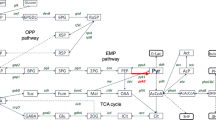Abstract
NADP-glutamate dehydrogenase (NADP-GDH) and NAD-glutamate dehydrogenase (NAD-GDH) activities from Bipolaris maydis race T (ATCC 36180) were determined by measuring the change in absorbance at 340 nm of either reduced NADP or NAD in a reaction mixture of NH4C1, α-ketoglutarate and a cell free extract of the fungus. NADP-GDH activity was high at 48 h, but low at 72 and 96 h when the fungus was incubated on a reciprocal shaker at 28 °C in a mineral salts medium containing 2 g/l glucose and 4 g/l Lasparagine. In contrast, in these cultures NAD-GDH activity was low at 48 h, but high at 72 and 96 h. At 72 and 96 h glucose was not detected in the culture medium. In addition, levels of ammonium and pH increased from 0.0 μmoles/ml and pH 5.8 at 48 h to 10.6 μmoles/ml and pH 7.2 at 72 h, and to 23.0 μmoles/ml and pH 8.4 at 96 h. Fungal mycelia were transferred after 48 h of incubation on media containing 2 g/l glucose and 4 g/l L-asparagine to fresh media containing 0, 2 or 5 g/l glucose with and without 4 g/l L-asparagine. Twenty-four h after transfer to fresh media containing 5 g/l glucose with L-asparagine or 2 or 5 g/l glucose without L-asparagine, NADP-GDH activity was high and NAD-GDH activity was low. Glucose was detected in the culture medium, ammonium was not detected and the pH remained unchanged or decreased. In contrast, 24 h after transfer to fresh media with 0 or 2 g/l glucose with L-asparagine and on media lacking glucose or L-asparagine, NADP-GDH activity was low and NAD-GDH activity was high. Glucose was not detected in the culture medium, ammonium levels were high and the pH increased. Thus, accumulation of ammonium and pH increases accompanying depletion of glucose in a L-asparagine medium could be related to a change in the capacity of B. maydis race T to assimilate and produce ammonium via pathways involving glutamate dehydrogenases.
Similar content being viewed by others
References
Bischoff TW: Ammonium production by Bipolaris maydis race T and its relationship to pH of the culture medium. PhD Dissertation, The Ohio State University, 1986.
Bischoff TW, Garraway MO: Changes in amount of ammonium released from L-asparagine by Bipolaris maydis race T. Ohio J Sci 85:14 (Abstr), 1985.
Bischoff TW, Garraway MO: The effect of xylose on the growth and sporulation of an isolate of Bipolaris maydis race T and its relationship to pH and ammonium levels. Phytopathology 75:138–141, 1985.
Buffo J, Herman MA, Soll DR: A characterization of pH-regulated dimorphism in Candida albicans. Mycopathologia 85:21–30, 1984.
Converse RH: The influence of nitrogenous compounds on the growth of Helminthosporium gramineum in culture. Mycologia 45:335–344, 1953.
Dantzig AH, Wiegmann Jr FL, Nason A: Regulation of glutamate dehydrogenases in nit-2 and mutants of Neurospora crassa. J. Bacterial 137:1333–1339, 1979.
Evans RC, Black CL: Interactions between nitrogen source and xylose affecting growth, sporulation polyphenoloxidase activity in Bipolaris maydis race T. Can J Bot 59:2102–2107, 1981.
Hrmova M, Drobnica L: Induction of mycelial type of development in Candida albicans by low glucose concentration. Mycopathologia 76:83–96, 1981.
Kapoor M, Grover AK: Catabolite-controlled regulation of glutamate dehydrogenases of Neurospora crassa. Can J Microbiol 16:33–40, 1970.
Kinghorn JR, Pateman JA: NAD and NADP L-glutamate dehydrogenase activity and ammonium regulation in Aspergillus nidulans. J Gen Microbiol 78:39–46, 1973.
Lowry OH, Rosebrough NJ, Farr AL & Randall RJ: Protein measurement with Folin Phenol reagent. J Biol Chem 193:265–275, 1951.
Miflin BJ, Lea PJ: The pathway of nitrogen assimilation in plants. Phytochemistry 15:873–885, 1976.
Moore D: Evidence that the NADP-linded glutamate dehydrogenase of Coprinus cinereus is regulated by acetylCoA and ammonium levels. Biochim Biophys Acta 661:247–254, 1981.
Nelson N: A photometric adaptation of the Somogyi method for the determination of glucose. J Biol Chem 193:265–275, 1944.
Rodriguez-Del Vallee N, Rosario M, Torres-Blasini G: Effects of pH, temperature, aeration and carbon source on the development of the mycelial and yeast forms of Sporothrix schenckii from conidia. Mycopathologia 82:83–88, 1983.
Sanwal BD, Lata M: Concurrent regulation of glutamic acid dehydrogenases of Neurospora. Arch Biochem Biophys 97:582–588, 1962.
Thomulka KW, Moat AG: Inorganic nitrogen assimilation in yeasts: alteration in enzyme activities associated with changes in cultural conditions and growth phase. J Bacteriol 109:25–33, 1972.
Author information
Authors and Affiliations
Rights and permissions
About this article
Cite this article
Bischoff, T.W., Garraway, M.O. Effects of glycose on NADP and NAD glutamate dehydrogenase activities and their relation to ammonium and pH levels in cultures of Bipolaris maydis race T. Mycopathologia 98, 141–148 (1987). https://doi.org/10.1007/BF00437649
Issue Date:
DOI: https://doi.org/10.1007/BF00437649




